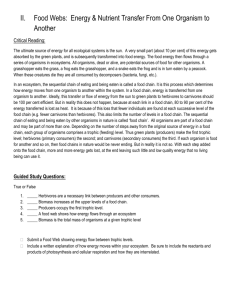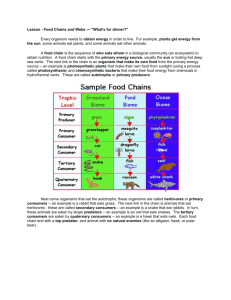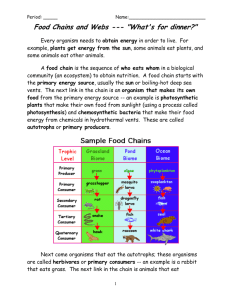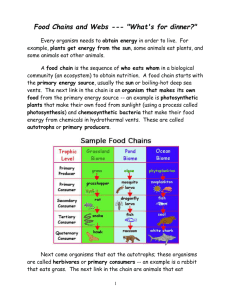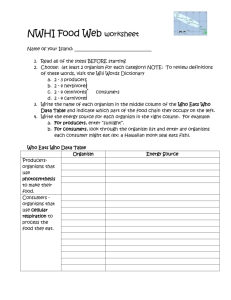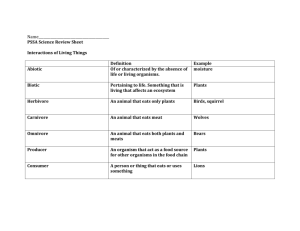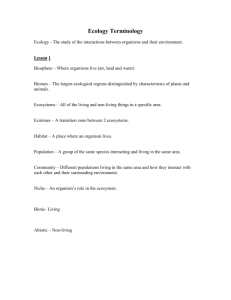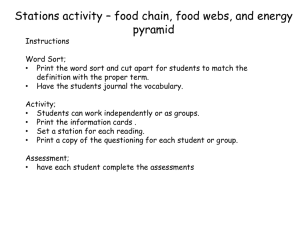Lesson Summaries Ecology
advertisement
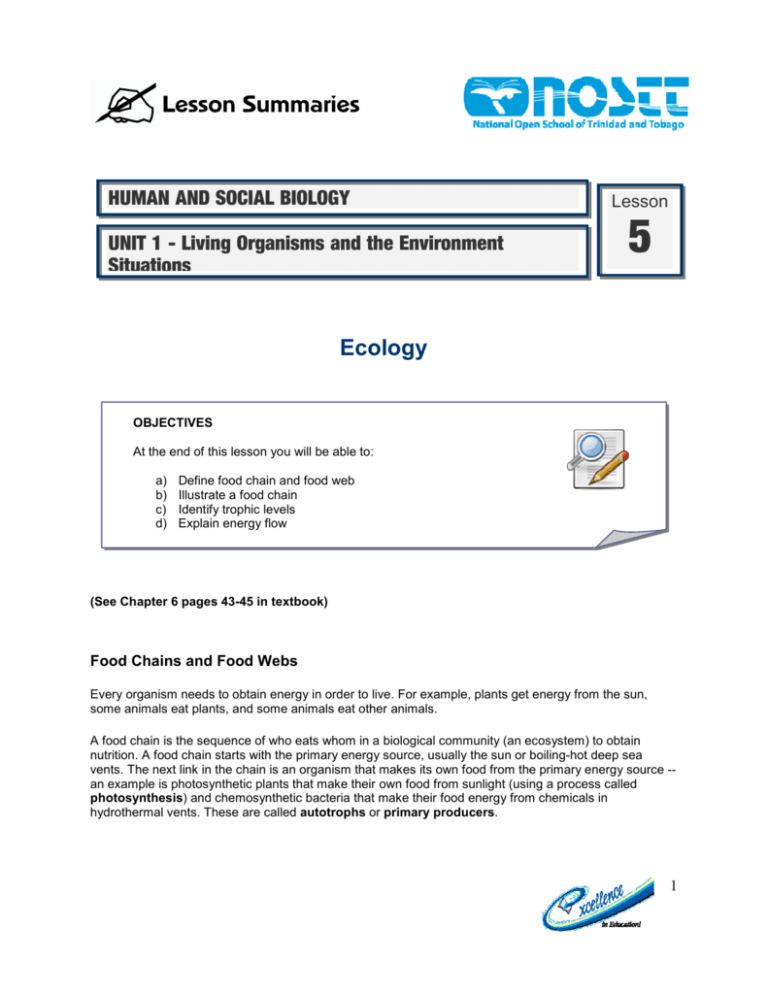
Lesson Summaries HUMAN AND SOCIAL BIOLOGY UNIT 1 - Living Organisms and the Environment Situations Lesson 5 Ecology OBJECTIVES At the end of this lesson you will be able to: a) b) c) d) Define food chain and food web Illustrate a food chain Identify trophic levels Explain energy flow (See Chapter 6 pages 43-45 in textbook) Food Chains and Food Webs Every organism needs to obtain energy in order to live. For example, plants get energy from the sun, some animals eat plants, and some animals eat other animals. A food chain is the sequence of who eats whom in a biological community (an ecosystem) to obtain nutrition. A food chain starts with the primary energy source, usually the sun or boiling-hot deep sea vents. The next link in the chain is an organism that makes its own food from the primary energy source -an example is photosynthetic plants that make their own food from sunlight (using a process called photosynthesis) and chemosynthetic bacteria that make their food energy from chemicals in hydrothermal vents. These are called autotrophs or primary producers. 1 Next come organisms that eat the autotrophs; these organisms are called herbivores or primary consumers -- an example is a rabbit that eats grass. The next link in the chain is animals that eat herbivores - these are called secondary consumers -- an example is a snake that eats rabbits. In turn, these animals are eaten by larger predators -- an example is an owl that eats snakes. The tertiary consumers are are eaten by quaternary consumers -- an example is a hawk that eats owls. Each food chain end with a top predator, and animal with no natural enemies (like an alligator, hawk, or polar bear). The arrows in a food chain show the flow of energy, from the sun or hydrothermal vent to a top predator. As the energy flows from organism to organism, energy is lost at each step. A network of many food chains is called a food web. Trophic Levels The trophic level of an organism is the position it holds in a food chain. 1. Primary producers (organisms that make their own food from sunlight and/or chemical energy from deep sea vents) are the base of every food chain - these organisms are called autotrophs. 2. Primary consumers are animals that eat primary producers; they are also called herbivores (plant-eaters). 3. Secondary consumers eat primary consumers. They are carnivores (meat-eaters) and omnivores (animals that eat both animals and plants). 4. Tertiary consumers eat secondary consumers. 5. Quaternary consumers eat tertiary consumers. 6. Food chains "end" with top predators, animals that have little or no natural enemies. When any organism dies, it is eventually eaten by detrivores (like vultures, worms and crabs) and broken down by decomposers (mostly bacteria and fungi), and the exchange of energy continues. Some organisms' position in the food chain can vary as their diet differs. For example, when a bear eats berries, the bear is functioning as a primary consumer. When a bear eats a plant-eating rodent, the bear is functioning as a secondary consumer. When the bear eats salmon, the bear is functioning as a tertiary consumer (this is because salmon is a secondary consumer, since salmon eat herring that eat zooplankton that eat phytoplankton, that make their own energy from sunlight). Think about how people's place in the food chain varies - often within a single meal. Numbers of Organisms In any food web, energy is lost each time one organism eats another. Because of this, there have to be many more plants than there are plant-eaters. There are more autotrophs than heterotrophs, and more plant-eaters than meat-eaters. Although there is intense competition between animals, there is also interdependence. When 2 one species goes extinct, it can affect an entire chain of other species and have unpredictable consequences. Equilibrium As the number of carnivores in a community increases, they eat more and more of the herbivores, decreasing the herbivore population. It then becomes harder and harder for the carnivores to find herbivores to eat, and the population of carnivores decreases. In this way, the carnivores and herbivores stay in a relatively stable equilibrium, each limiting the other's population. A similar equilibrium exists between plants and plant-eaters. Diagram of a food chain 3 Diagram of a food web Trophic Level Trophic levels are the feeding position in a food chain such as primary producers, herbivore, primary carnivore, etc. Green plants form the first trophic level, the producers. Herbivores form the second trophic level, while carnivores form the third and even the fourth trophic levels. 4 ASSESSMENT FOOD CHAIN QUESTIONS 1) Look at the following food chain. Seaweed a) b) c) d) e) f) Limpet Starfish Cod Which organisms are carnivores? What organism is at trophic level 3? What is the producer? Name the herbivore. Name an organism that eats starfish. Where does the energy in this food chain come from? 2) Write your own food chain with humans at the top. 3) Here is another food chain. Oak tree a) b) c) d) e) Greenfly Ladybird Blue tit Hawk Name a carnivore. Name a herbivore. Which organism is at trophic level 5? Name the producer. Name the secondary consumer. 4) All the life in a pond depends on microscopic plants called algae making food by photosynthesis. Small animals like mosquito larvae then eat the algae. Bigger animals like sticklebacks then eat the mosquito larvae, and these sticklebacks are eaten by even bigger fish like perch. a) b) c) d) Draw the food chain that is described above. What is the producer in this food chain? What is the primary consumer? What would happen to the mosquito larvae if someone put weed killer in the pond and killed all the algae? e) What would happen to the number of sticklebacks if all the perch died of a disease? f) Some pike are introduced into the pond. They eat perch. Add them to your food chain. g) Explain what happen to the number of i) Perch. ii) Sticklebacks. 5
